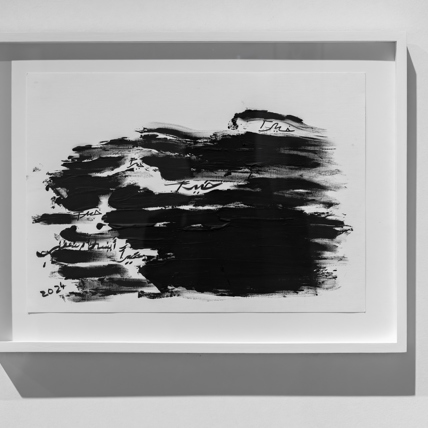Anisa Ashkar | Dogs and More


Anisa Ashkar’s works, which span a range of mediums and techniques, originated from her physical and biographical journey between cities and spaces – Jaffa, Tel Aviv, Acre, and Paris – which have become sites of identity, memory, and foreignness.
Ashkar’s painting style is characterized by layers of paint and material traces of the human body, and often include Arabic calligraphy, which is an integral part of the visual and political language of her work.
The exhibition features works from a new series that was inspired by Ashkar’s growing collection of porcelain dog figurines and urban strolls, during which she looks at shop windows. “I have waited for a very long time to connect the dogs in my porcelain figurine collection with my artworks, and in this exhibition, I found the opportunity to combine my love of dogs with porcelain figurines from shop windows around the world and in Tel Aviv, which embraced me 20 years ago.”
In each of these works, Ashkar creates a Tel Avivian display window of sorts, based on childhood images and material memories: houses she used to build in the sand, fictional scenes, collectible items. Together, the figurines and the objects create intimate and charged mise-en-scènes, combining humor, compassion, and a childlike feeling, challenging the distinction and hierarchy between the commonplace and the fantastic. In “The City and Cottage,” for example, a black-and-white dog arrives at the City Museum square, where she drinks water and is rewarded with cottage cheese and pearls.
For Ashkar, these display window works are not just a tribute to the world of her childhood, but also the extension of an ongoing dialogue with museums and “cabinets of curiosities,” where she spent much of her adult life. She now creates such rooms for herself – personal, local, and critical.
In addition, the exhibition also features works from two other series by Ashkar, titled “My Dear: Jaffa” and “Ya-Habibi Tel Aviv.” These focus on the dual city Tel Aviv-Yafo – as a space of life, tensions, and belonging.
The recurring use of black and white in Ashkar’s work brings to mind modernist references, but also carries personal, material, and cultural meanings. Another work displayed in the middle of one of the museum’s walls, “Khairan” (“blessings” in Arabic), is an elaboration of this aspect, where the word “Khairan” is written over and over again. “It all comes down to this never-ending work,” says the artist. “For 18 months I have been swimming in a sea of blackness writing the word ‘khairan,’ meaning, ‘blessings,’ over and over again among the waves. The repetitiveness is like a mantra of boundless faith. Childhood continues into adulthood, the search for innocence, so that there can only be good blessings.”

